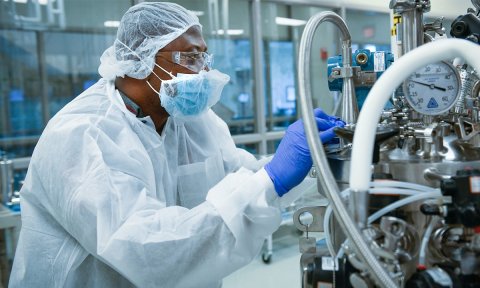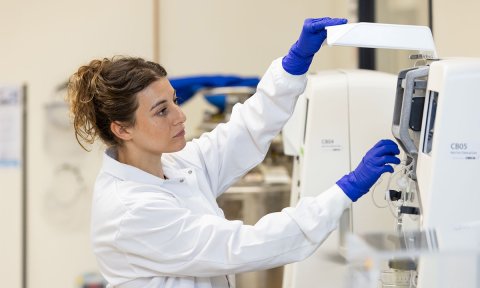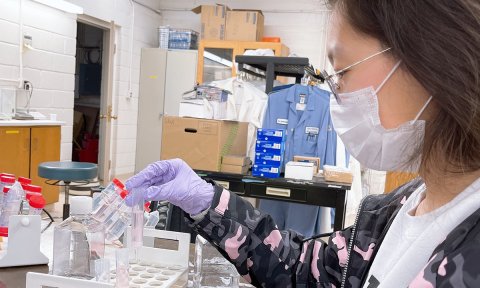While the U.S. legacy manufacturing sector continues to build a skilled workforce, secure the domestic supply chain, and widely adopt technological innovations, there is an area in which the U.S. is positioned to secure global leadership - the bioeconomy.
The bioeconomy is often cited as a pathway to securing everything from climate change and sustainability, to food security, energy independence, and personalized health. Products, services, and processes derived from biological resources (cell lines, plants and microorganisms) will be a key component of the future global economy.
Innovation in the bioeconomy will create new industries and high-paying jobs, expand domestic manufacturing and help secure critical supply chains for a resilient and competitive future. It will improve human health through the development of new therapies, drugs, and diagnostics.
The Biden Administration has put a major emphasis on the bioeconomy through its executive order, setting out a National Biotechnology and Biomanufacturing Initiative (NBBI), which includes training to build the bio workforce of the future. The administration estimates that the bioeconomy, which is about 5 percent of the national gross domestic product, could grow to about 33 percent of global output, or about $30 trillion annually.
Three innovation institutes in the Manufacturing USA network are at the forefront of the bioeconomy. BioMADE, BioFabUSA, and NIIMBL are working at the intersection of biology, technology, and sustainability to drive the widespread adoption of biomanufacturing.
Biomanufacturing Can Be Applied to Many Industries
Bioindustrial manufacturing uses biological systems – including microbes such as bacteria, yeast, and algae – to create new materials or sustainable alternatives to existing petroleum-based materials. The reality for almost every industry, from agriculture to textiles to energy, is that if you can manufacture it through chemistry, you can do so with biology, according to Melanie Tomczak, BioMADE’s Chief Technology Officer and Head of Programs.

Nearly all legacy manufacturing is based on the use of energy, such as heat, to change the form of a component or material. The biological process on which nearly all biomanufacturing is based is a fairly common one, fermentation. But the technology used for large-scale fermentation – bioreactors – has largely remained unchanged for the past few decades. Large-scale bioreactors are not portable, require large amounts of inputs, produce a lot of waste, and are expensive to operate.
Tomczak says biomanufacturing’s “time is now.” While it is being used for many commercial applications, innovations are in development in many areas and specifically to redesign bioreactors to be more efficient, lower cost, more flexible and re-deployable. The redesigned reactors will account for the complex dynamics of microbial fermentation and lead to more efficient downstream processes such as separation. Technological innovations in bioreactor hardware, software, sensors, modeling, and automation will soon make it more economical to manufacture bio-based products at commercial scale.
One of the biggest challenges facing the industry is the lack of facilities and equipment to bring technologies to scale. BioMADE recently announced a $300 million Department of Defense investment to build the first phase of biomanufacturing infrastructure sites around the country.
BioMADE, with bipartisan support from Governor Walz and the Minnesota Legislature, will construct a bio-industrial manufacturing pilot facility in Minnesota, the first in a national network of bioindustrial manufacturing facilities. At full buildout, officials envision a $1.5 billion national network of 12 to 15 pilot-scale biomanufacturing sites. These facilities are critically needed around the country to develop the domestic infrastructure to help transition technology innovations from a laboratory setting to commercial production.
The production sites will vary across the country. A campus in Minnesota will include a pilot-scale production facility and the opportunity for BioMADE member companies and startups to co-locate their production facilities. Facilities will be designed to tap into regional feedstocks; for example, Midwestern sites could be dedicated to corn feedstock, while another could specialize in research and development focused on other local agricultural byproducts such as nut shells or rice waste. Other sites might focus on purification or brownfield applications instead of fermentation.
BioMADE and its members have many success stories that illustrate the potential power of these pilot facilities. Here are four:
- Sustainable materials development: More than 90 percent of the domestic rubber supply comes from rubber trees in Southeast Asia or South America. A project team at BioMADE has figured out how to produce an equivalent to natural rubber from a type of dandelion that has an extensive root system and can be grown almost anywhere. The root feedstock will be used in large-scale batch-style equipment to produce significant amounts of rubber and resins at near commercial scale. MicroByre takes waste from the dairy industry to generate a cheap and sustainable alternative to displace petroleum-based propylene as a feedstock to make acrylic acid, which is used to make thousands of chemicals. Processing can be located near dairy processing plants, also helping that industry reduce its carbon emissions.
- Sustainable fabrics: Rubi Laboratories uses enzymes to convert carbon emission into cellulose pulp, which is spun into yarn and textiles to make clothing.
- Preventing disease: General Probiotics has developed a feed active for use in poultry facilities that has led to a significant reduction in chicken mortality and will help farmers raise healthy animals that are free from foodborne pathogens.
Improving biomanufacturing processes and facilities will enable production of useful products and sustainable alternatives to existing petroleum-based materials in a broad range of sectors including health, nutrition, agriculture, and industry.
Charting the Growth Path for Regenerative Medicine
Regenerative Medicine holds the promise of transforming healthcare for chronic illness and traumatic injury, but the potential for these curative therapies and treatments have not yet been realized. Historically, discoveries have stalled in the lab given challenges with scaling the processes necessary to move to commercialization.
BioFabUSA is removing the hurdles to manufacture cells, tissues, and organs by building the biofabrication industry needed to reliably produce and scale regenerative therapies. BioFabUSA's member-driven, interdisciplinary approach brings together engineering, robotics, automation biochemistry, regulatory science, medicine, and commercialization expertise. Together they tackle challenges ranging from biomanufacturing to data gathering to the regulatory pathway needed for approval of treatments for diseases like diabetes and traumatic injuries suffered by warfighters and others.
“Cell-based therapies can be cost-effective and scalable with the right engineering expertise, robotics, automation, data science, and more.”
For example, BioFabUSA has built the Tissue Foundry, the first demonstration of scalable, modular, automated, and closed manufacturing for a tissue engineered product. The prototype line produced a bone-ligament-bone construct to treat joint injuries, such as with knee or shoulder ligaments. The technology is readily adaptable to other cell-based products.
These developments have long-term implications for the future of biofabrication and the goal of replacing human organs to fundamentally transform healthcare for chronic illness and traumatic injury. The opportunity is immense, as there are more than 100,000 people on a transplant waiting list at any given time, and 60 percent of Americans live with a chronic illness or condition.

Type 1 diabetes is a prime example of the opportunity for more efficient and effective therapies. BioFabUSA and its members are working to develop and scale the manufacturing of replacement pancreatic islet cells. This curative therapy will eliminate the need for synthetic insulin and all the complexity and risk that comes with the continuous dosing currently required to live with type 1 diabetes.
“Cells are the most exquisite sensors that exist,” Jennifer MacDonald, BioFabUSA’s Chief Operating Officer says. “Cell-based therapies can be cost-effective and scalable with the right engineering expertise, robotics, automation, data science, and more.”
But for that kind of transformation to happen, the industry must develop continuous measurements and quality control standards to move through FDA approval. It involves data science for consistent analysis, and models and simulation to scale manufacturing.
“There is a very real opportunity in front of us to make real of what has been the potential of regenerative medicine,” MacDonald says.
One of MacDonald’s reasons for optimism is that the emerging biofabrication industry has been working closely with regulatory standards from the beginning in a highly intentional process to incorporate technology with biology. They are pre-managing everything they can account for from regulatory concerns and manufacturing efficiencies because it can cost five times or more to fix manufacturing operational platforms in the field versus in the development process.
“There is a palpable closeness between companies and research,” MacDonald says.
MacDonald points out the opportunity to invest now in biofabrication to ensure U.S. global leadership as the industry is on the verge of significant expansion. For example, the BioFab Startup Lab had five times the applicants for its first cohort than resources could support.
Unlocking the Power of Biological Systems to Treat Many Ailments
One of the reasons for optimism in the bioeconomy is a new paradigm in which big global companies in pharmaceutical manufacturing have come together to demonstrate advances in a shared way, says Kelvin H. Lee, Director of the National Institute for Innovation in Manufacturing Biopharmaceuticals (NIIMBL) and the Gore Professor of Chemical and Biomolecular Engineering at the University of Delaware.
NIIMBL’s ecosystem is a public-private partnership demonstrating how an approach in which everyone “can go first together” will help de-risk technology investments in such a highly regulated environment.

Unlike regenerative medicine and other emerging sectors, there is less incentive to be first with a new process in biopharmaceutical manufacturing, when any one of more than 100 health authorities around the world must individually approve the manufacturing. Big companies want to go as fast as possible to get to market, so they often follow a path of lower risk by using an established technology, while waiting to be a fast follower of another company’s risk.
Lee says that dynamic has made it difficult to get new medicines manufactured with new processes through the development pipeline. It helps explain why flu vaccines are still produced the way they were 40 years ago.
One example of the new paradigm is the development of a Buffer Stock Blending System. Buffer solutions are essential to manufacturing therapeutic proteins and other biomolecules, but they challenge production in terms of facility use, supply chain management, and operations. The blending system technology, developed in a project at NIIMBL in collaboration with BioPhorum and several companies, has been made available in an open-source format. The blending system reduces the time it takes to manufacture 2,000 liters of buffer solution from eight hours to less than an hour, which significantly reduces capital and operating costs, and environmental footprints, of biopharmaceutical facilities.
By de-risking investment costs in a highly regulated environment, NIIMBL helps make a stronger business case for innovation in the low-volume, high-margin world of biopharmaceutical manufacturing.
Empowering the Future Bioeconomy
Institutes’ technology innovations are helping to build out the bioeconomy. These innovations will strengthen the competitive position of U.S. manufacturing companies, provide pathways to Americans seeking rewarding, living-wage jobs, and contribute to stronger local, regional, and national communities.
In 2022, the institutes collectively worked with over 2,500 member organizations to collaborate on more than 670 major technology and workforce research and development projects, and engaged over 106,000 people in advanced manufacturing training. State, industry, and federal funds contributed $416 million to these activities.
To learn about the many ways institutes are helping build out the bioeconomy, visit our clean energy page.

